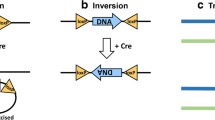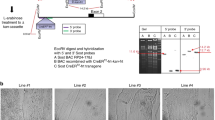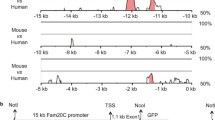Abstract
Introduction
The conditional manipulation of genes using the Cre recombinase-locus of crossover in P1 (Cre/loxP) system is an important tool for revealing gene functions and cell lineages in vivo. The outcome of this method is dependent on the performance of Cre-driver mouse strains. In most cases, Cre knock-in mice show better specificity than randomly inserted Cre transgenic mice. However, following knock-in, the expression of the original gene replaced by Cre is lost.
Materials and methods
We generated a new differentiated osteoblast- and osteocyte-specific Cre knock-in mouse line that carries the viral T2A sequence encoding a 2A self-cleaving peptide at the end of the coding region of the dentin matrix protein 1 (Dmp1) gene accompanied by the Cre gene.
Results
We confirmed that Dmp1-T2A-Cre mice showed high Cre expression in osteoblasts, osteocytes, odontoblasts, and periodontal ligament cells and that the 2A self-cleaving peptide efficiently produced both Dmp1 and Cre proteins. Furthermore, unlike the Dmp1 knockout mice, homozygous Dmp1-T2A-Cre mice showed no skeletal abnormalities. Analysis using the Cre reporter strain confirmed differentiated osteoblast- and osteocyte-specific Cre-mediated recombination in the skeleton. Furthermore, recombination was also detected in some nuclei of skeletal muscle cells, spermatocytes, and intestinal cells.
Conclusion
2A-Cre functions effectively in vivo, and Dmp1-T2A-Cre knock-in mice are a useful tool for studying the functioning of various genes in hard tissues.




Similar content being viewed by others
References
Robling AG, Bonewald LF (2020) The osteocyte: new insights. Annu Rev Physiol 82:485–506. https://doi.org/10.1146/annurev-physiol-021119-034332
Qin L, Liu W, Cao H, Xiao G (2020) Molecular mechanosensors in osteocytes. Bone Res 8:1–24. https://doi.org/10.1038/s41413-020-0099-y
Fisher LW, Torchia DA, Fohr B et al (2001) Flexible structures of SIBLING proteins, bone sialoprotein, and osteopontin. Biochem Biophys Res Commun 280:460–465. https://doi.org/10.1006/bbrc.2000.4146
Feng JQ, Huang H, Lu Y et al (2003) The dentin matrix protein 1 (Dmp1) is specifically expressed in mineralized, but not soft, tissues during development. J Dent Res 82:776–780. https://doi.org/10.1177/154405910308201003
Oya K, Ishida K, Nishida T et al (2017) Immunohistochemical analysis of dentin matrix protein 1 (Dmp1) phosphorylation by Fam20C in bone: Implications for the induction of biomineralization. Histochem Cell Biol 147:341–351. https://doi.org/10.1007/s00418-016-1490-z
Fukumoto S, Martin TJ (2009) Bone as an endocrine organ. Trends Endocrinol Metab 20:230–236. https://doi.org/10.1016/j.tem.2009.02.001
Martin A, Liu S, David V et al (2011) Bone proteins PHEX and DMP1 regulate fibroblastic growth factor Fgf23 expression in osteocytes through a common pathway involving FGF receptor (FGFR) signaling. FASEB J 25:2551–2562. https://doi.org/10.1096/fj.10-177816
Ye L, Mishina Y, Chen D et al (2005) Dmp1-deficient mice display severe defects in cartilage formation responsible for a chondrodysplasia-like phenotype. J Biol Chem 280:6197–6203. https://doi.org/10.1074/jbc.M412911200
Feng JQ, Ward LM, Liu S et al (2006) Loss of DMP1 causes rickets and osteomalacia and identifies a role for osteocytes in mineral metabolism. Nat Genet 38:1310–1315. https://doi.org/10.1038/ng1905
Li X, Zhang Y, Kang H et al (2005) Sclerostin binds to LRP5/6 and antagonizes canonical Wnt signaling. J Biol Chem 280:19883–19887. https://doi.org/10.1074/jbc.M413274200
Xiong J, Onal M, Jilka RL et al (2011) Matrix-embedded cells control osteoclast formation. Nat Med 17:1235–1241. https://doi.org/10.1038/nm.2448
Nakashima T, Hayashi M, Fukunaga T et al (2011) Evidence for osteocyte regulation of bone homeostasis through RANKL expression. Nat Med 17:1231–1234. https://doi.org/10.1038/nm.2452
Bélanger LF (1969) Osteocytic osteolysis. Calcif Tissue Res 4:1–12. https://doi.org/10.1007/BF02279101
Nango N, Kubota S, Hasegawa T et al (2016) Osteocyte-directed bone demineralization along canaliculi. Bone 84:279–288. https://doi.org/10.1016/j.bone.2015.12.006
Kato Y, Windle JJ, Koop BA et al (1997) Establishment of an osteocyte-like cell line, MLO-Y4. J Bone Miner Res 12:2014–2023. https://doi.org/10.1359/jbmr.1997.12.12.2014
Woo SM, Rosser J, Dusevich V et al (2011) Cell line IDG-SW3 replicates osteoblast-to-late-osteocyte differentiation in vitro and accelerates bone formation in vivo. J Bone Miner Res 26:2634–2646. https://doi.org/10.1002/jbmr.465
Kalajzic I, Matthews BG, Torreggiani E et al (2013) In vitro and in vivo approaches to study osteocyte biology. Bone 54:296–306. https://doi.org/10.1016/j.bone.2012.09.040
Schmidt-Supprian M, Rajewsky K (2007) Vagaries of conditional gene targeting. Nat Immunol 8:665–668. https://doi.org/10.1038/ni0707-665
Dallas SL, Xie Y, Shiflett LA, Ueki Y (2018) Mouse Cre models for the study of bone diseases. Curr Osteoporos Rep 16:466–477. https://doi.org/10.1007/s11914-018-0455-7
Lu Y, Xie Y, Zhang S et al (2007) DMP1-Targeted Cre expression in odontoblasts and osteocytes. J Dent Res 86:320–325. https://doi.org/10.1177/154405910708600404
Bivi N, Condon KW, Allen MR et al (2012) Cell autonomous requirement of connexin 43 for osteocyte survival: Consequences for endocortical resorption and periosteal bone formation. J Bone Miner Res 27:374–389. https://doi.org/10.1002/jbmr.548
Song AJ, Palmiter RD (2018) Detecting and avoiding problems when using the Cre–lox system. Trends Genet 34:333–340. https://doi.org/10.1016/j.tig.2017.12.008
Cui Y, Niziolek PJ, MacDonald BT et al (2011) Lrp5 functions in bone to regulate bone mass. Nat Med 17:684–691. https://doi.org/10.1038/nm.2388
Lim J, Burclaff J, He G et al (2017) Unintended targeting of Dmp1-Cre reveals a critical role for Bmpr1a signaling in the gastrointestinal mesenchyme of adult mice. Bone Res 5:1–8. https://doi.org/10.1038/boneres.2016.49
Becher B, Waisman A, Lu LF (2018) Conditional gene-targeting in mice: problems and solutions. Immunity 48:835–836. https://doi.org/10.1016/j.immuni.2018.05.002
Maeda K, Kobayashi Y, Udagawa N et al (2012) Wnt5a-Ror2 signaling between osteoblast-lineage cells and osteoclast precursors enhances osteoclastogenesis. Nat Med 18:405–412. https://doi.org/10.1038/nm.2653
Akiyama H, Kim JE, Nakashima K et al (2005) Osteo-chondroprogenitor cells are derived from Sox9 expressing precursors. Proc Natl Acad Sci USA 102:14665–14670. https://doi.org/10.1073/pnas.0504750102
Mizuguchi H, Xu Z, Ishii-Watabe A et al (2000) IRES-dependent second gene expression is significantly lower than cap-dependent first gene expression in a bicistronic vector. Mol Ther 1:376–382. https://doi.org/10.1006/mthe.2000.0050
Ryan MD, Flint M (1997) Virus-encoded proteinases of the picornavirus super-group. J Gen Virol 78:699–723. https://doi.org/10.1099/0022-1317-78-4-699
Szymczak AL, Workman CJ, Wang Y et al (2004) Correction of multi-gene deficiency in vivo using a single “self-cleaving” 2A peptide-based retroviral vector. Nat Biotechnol 22:589–594. https://doi.org/10.1038/nbt957
Madisen L, Zwingman TA, Sunkin SM et al (2010) A robust and high-throughput Cre reporting and characterization system for the whole mouse brain. Nat Neurosci 13:133–140. https://doi.org/10.1038/nn.2467
Nakamura T, Nakamura-Takahashi A, Kasahara M et al (2020) Tissue-nonspecific alkaline phosphatase promotes the osteogenic differentiation of osteoprogenitor cells. Biochem Biophys Res Commun 524:702–709. https://doi.org/10.1016/j.bbrc.2020.01.136
Kawamoto T, Shimizu M (2000) A method for preparing 2-to 50-μm-thick fresh-frozen sections of large samples and undecalcified hard tissues. Histochem Cell Biol 113:331–339. https://doi.org/10.1007/s004180000149
Yagi T, Tokunaga T, Furuta Y et al (1993) A novel ES cell line, TT2, with high germline-differentiating potency. Anal Biochem 214:70–76
Terasawa M, Shimokawa R, Terashima T et al (2004) Expression of dentin matrix protein 1 (DMP1) in nonmineralized tissues. J Bone Miner Metab 22:430–438. https://doi.org/10.1007/s00774-004-0504-4
Wilson MJ, Liaw L, Koopman P (2005) Osteopontin and related SIBLING glycoprotein genes are expressed by sertoli cells during mouse testis development. Dev Dyn 233:1488–1495. https://doi.org/10.1002/dvdy.20456
Feng JQ, Zhang J, Dallas SL et al (2002) Dentin matrix protein 1, a target molecule for Cbfa1 in bone, is a unique bone marker gene. J Bone Miner Res 17:1822–1831. https://doi.org/10.1359/jbmr.2002.17.10.1822
Torreggiani E, Matthews BG, Pejda S et al (2013) Preosteocytes/osteocytes have the potential to dedifferentiate becoming a source of osteoblasts. PLoS One. https://doi.org/10.1371/journal.pone.0075204
Terada M, Lan YB, Kawano F et al (2010) Myonucleus-related properties in soleus muscle fibers of mdx mice. Cells Tissues Organs 191:248–259. https://doi.org/10.1159/000240245
Nakamura T, Imai Y, Matsumoto T et al (2007) Estrogen prevents bone loss via estrogen receptor α and induction of fas ligand in osteoclasts. Cell 130:811–823. https://doi.org/10.1016/j.cell.2007.07.025
Debnath S, Yallowitz AR, McCormick J et al (2018) Discovery of a periosteal stem cell mediating intramembranous bone formation. Nature 562:133–139. https://doi.org/10.1038/s41586-018-0554-8
Tsukasaki M, Komatsu N, Negishi-Koga T et al (2022) Periosteal stem cells control growth plate stem cells during postnatal skeletal growth. Nat Commun 13:4166. https://doi.org/10.1038/s41467-022-31592-x
Dzamukova M, Brunner TM, Miotla-Zarebska J et al (2022) Mechanical forces couple bone matrix mineralization with inhibition of angiogenesis to limit adolescent bone growth. Nat Commun 13:1–12. https://doi.org/10.1038/s41467-022-30618-8
Acknowledgements
We thank Drs. Yuko Nakamichi, Yasuharu Kurokawa, Takahito Okudaira, Naoko Irie, Yasunari Takada, Tsukasa Oikawa and Mr. Gen Sakai for technical help and discussion; Dr. Shinichi Aizawa for the DT-ApA/conditional KO FW plasmid and TT2 ES cells; Dr. Neal Copeland for the PL451 plasmid; Dr. Akira Yamaguchi for continued support.
Funding
This work was supported by the Suematsu Gas Biology Project, Exploratory Research for Advanced Technology, from the Japan Science and Technology Agency and by grants from the Grants-in-Aid for Young Scientists A (23689067), Challenging Exploratory Research (26670673), and Scientific Research C (21K09214) from the Japan Society for the Promotion of Science (JSPS).
Author information
Authors and Affiliations
Contributions
TN designed and performed most experiments, interpreted the results, and wrote the manuscript. SH, TY, and YK contributed to the generation and characterization of the Dmp1-T2A-Cre mice and data interpretation. SI, TM, and MK contributed to the characterization of the Dmp1-T2A-Cre mice and data interpretation. KM and MS supervised the project and wrote the manuscript.
Corresponding authors
Ethics declarations
Conflict of interest
All authors have no conflicts of interest.
Ethical approval
Prior to the study, all experiments were reviewed and approved by the Animal Care and Use Committee of Keio University (No. 12039) and Tokyo Dental College (No. 300402, No. 300706). This study is reported in accordance with the ARRIVE guidelines.
Additional information
Publisher's Note
Springer Nature remains neutral with regard to jurisdictional claims in published maps and institutional affiliations.
About this article
Cite this article
Nakamura, T., Honda, S., Ito, S. et al. Generation of bicistronic Dmp1-Cre knock-in mice using a self-cleaving 2A peptide. J Bone Miner Metab 41, 470–480 (2023). https://doi.org/10.1007/s00774-023-01425-y
Received:
Accepted:
Published:
Issue Date:
DOI: https://doi.org/10.1007/s00774-023-01425-y




